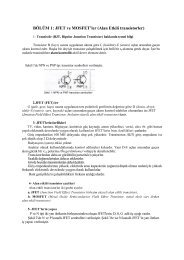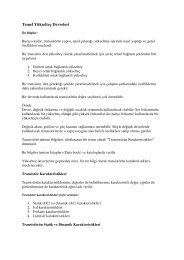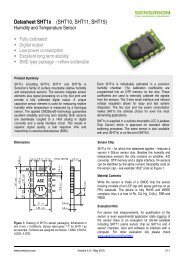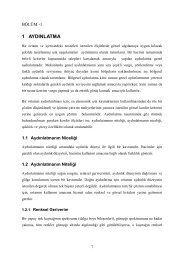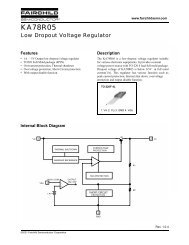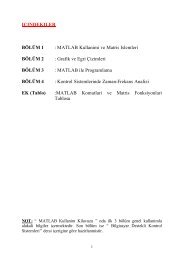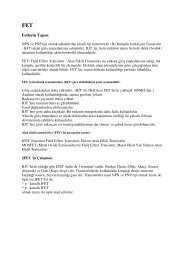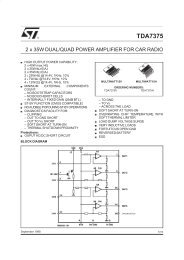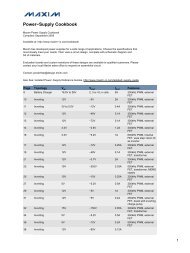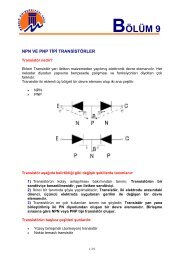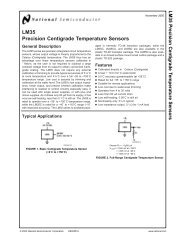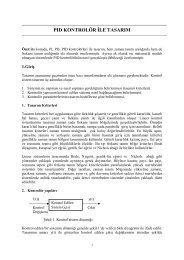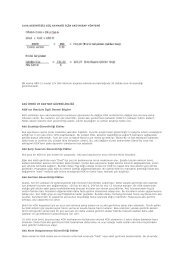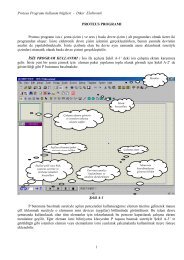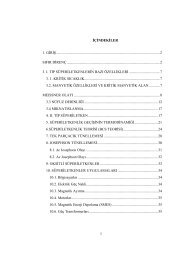DIY Kit 130. Door Minder - 320Volt
DIY Kit 130. Door Minder - 320Volt
DIY Kit 130. Door Minder - 320Volt
Create successful ePaper yourself
Turn your PDF publications into a flip-book with our unique Google optimized e-Paper software.
CK1620 - <strong>Door</strong> <strong>Minder</strong><br />
This kit uses an infrared beam to monitor door & passageways<br />
or any other area. When the beam is broken a relay is<br />
tripped which can be used to sound a bell or alarm. Suitable<br />
for detecting customers entering a shop, cars coming up a<br />
driveway, etc. The IR beam is very strong. Distances over 25<br />
yards can be monitored with this <strong>Kit</strong>. A 12VDC supply is<br />
required to power the kit. A 12V wall adaptor is fine.<br />
Provision has been made so that only one power supply<br />
needs to be used to power both units. The relays in this kit<br />
are rated to switch mains voltages.<br />
The kit is constructed on single-sided printed circuit board.<br />
Protel Autotrax for DOS was used in the design.<br />
CONSTRUCTION<br />
The kit is built on two separate PCBs – a transmitter PCB<br />
(K130T) and a receiver PCB (K130R). Refer to the parts list<br />
to see which components belong to which board. Use the<br />
component overlay on each PCB to place the components.<br />
Transmitter board<br />
Insert the lowest height components first. Leave the infrared<br />
LED and power jack until last. Make sure that the electrolytic<br />
capacitor and 4 diodes are inserted correctly. IC sockets are<br />
supplied for the ICs. Note there are two links to add to the<br />
board. One is under an IC.<br />
The IR LED can be mounted vertically or at right angles to<br />
the PCB. This will depend on how the transmitter will be<br />
mounted when in use. In either case the LED must be<br />
inserted the right way round. The flat edge on the LED<br />
should line up with the flat edge on the PCB overlay marked<br />
‘K’.<br />
Lastly, if the distance to be monitored is less than about 10<br />
yards then you will need to fit the 5mm shrink tubing over<br />
the IR LED. This narrows the radiating angle of the IR beam<br />
and makes it much more directional. The IR output is strong.<br />
It can easily bounce off walls etc to give false readings. Note<br />
that the red color shrink tubing is transparent to IR and will<br />
not act as IR shielding. The black tubing is the one to use.<br />
Receiver board<br />
As with the transmitter board, start with the lowest height<br />
components first - resistors, diodes, capacitors and<br />
transistors. Note the polarity of the electrolytic capacitors and<br />
diodes. Next insert the screw terminal block, power jacks and<br />
relay. Last of all is the infrared receiver module. The<br />
orientation is clearly shown on the PCB overlay: : the<br />
detecting lens bump faces outwards. Power must be center<br />
positive. A protection diode D4 is there to protect the circuit<br />
if the wrong polarity is plugged in.<br />
CIRCUIT DESCRIPTION - Transmitter Board<br />
The transmitter board consists of two square-wave<br />
oscillators, one running at approx. 250Hz and the other<br />
running at 38kHz. The 38kHz frequency acts as a carrier<br />
wave and is required by the IR receiver module on the<br />
receiver board. This carrier wave is “ANDed” or modulated<br />
by the 250Hz frequency to produce an output signal that<br />
contains bursts of 38kHz at a rate of 250Hz. This signal is<br />
used to drive an infrared LED. The oscillators are made by<br />
PAGE 1<br />
using two 555 timer ICs set up as “astable” (free running)<br />
multivibrators. IC1 is used for the 250Hz oscillator. Resistor<br />
R1 and R2 and capacitor C1 set the frequency. Another 555<br />
chip, IC2, is used for the 38KHz oscillator. Resistors R4 and<br />
R5 and capacitor C3 set the frequency.<br />
Notice the diodes D1 and D3. These are provided to create a<br />
“symmetrical” output. Normally the external capacitor C1<br />
(C3) charges through resistors R1 and R2 (R4 and R5) and<br />
discharges through R2 (R5). Without the diodes this output<br />
waveform would have a longer “high” time than the “low”<br />
time. The diode bypasses resistor R2 (and R5) when the<br />
capacitor is charging, so that it is only charged via R1 (or<br />
R5). This gives the same charging and discharging time and<br />
so the output waveform has equal high and low times.<br />
The charge time (output high) is given by:<br />
T HIGH = 0.693 x R1 x C1 (or 0.693 x R4 x C3)<br />
The discharge time (output low) is given by:<br />
T LOW = 0.693 x R2 x C1 (or 0.693 x R5 x C3)<br />
The output frequency = 1 / (T HIGH + T LOW )<br />
For an excellent website describing all this and more go to<br />
http://www.uoguelph.ca/~antoon/gadgets/555/555.html<br />
For an animation of the 555 as an astable multivibrator see<br />
http://www.williamson-labs.com/480_555.htm<br />
The output from the IC1 is coupled via diode D2 and resistor<br />
R3 to the ‘trigger’ input of IC2. When the IC1 output is low<br />
it stops IC2 from running and IC2’s output is forced high (no<br />
IR LED current). When IC1 output is high, IC2 runs and the<br />
IR LED is pulsed at 38KHz.<br />
The Waitrony IR LED is driven directly from the output of<br />
IC2. Resistor R6 sets the maximum LED current. With a<br />
12VDC supply the current is about 45mA (the LED drops 2V<br />
across it when conducting). Lowering the value of R6 will<br />
increase the current through the LED thus boosting the signal<br />
strength. This may be necessary if the kit is used outside in<br />
direct sunlight or if you need “very long range”. Keep in<br />
mind that the maximum current that the 555 can handle is<br />
200mA. See the IR LED data sheet at<br />
http://kitsrus.com/pdf/ie-0530hp.pdf<br />
Receiver Board<br />
The receiver consists of an IR receiver module that detects<br />
the incoming IR beam from the transmitter. The IR signal is<br />
used to keep a capacitor charged which in turn holds a relay<br />
operated. When the beam is broken the capacitor discharges<br />
and the relay releases.<br />
A Kodenshi IR receiver/detector module, RX1, is made up of<br />
an an amplifier/filter circuit tuned to detect a 38kHz<br />
frequency. The output pin is low whenever a 38kHz signal is<br />
detected.



